Tewkesbury
Explore hidden histories, historic photos, and things you never knew about Tewkesbury from the collections and archives of Historic England.
Discover your local listed buildings and places
Introducing some of Tewkesbury's most historic sites, included in the National Heritage List for England. Some of these captions have been summarised by AI. Click through for the official List entry. Skip this section and go to place by numbers
Healings Flour Mill and Warehouses
Tewkesbury
A flour mill of 1865 with warehouses of 1870s and 1880s dates.
Battle of Tewkesbury 1471
Tewkesbury
The site of the Battle of Tewkesbury 1471 which ended the second phase of the Wars of the Roses and saw the position of Edward IV on the English throne secured.
Toddington Manor
Toddington
Toddington Manor, designed by Charles Hanbury-Tracy in the 19th century, is a Gothic-style mansion with extensive historic and architectural significance in Gloucestershire.
Church of St Michael and All Angels
Stanton
The Church of St Michael and All Angels features architecture from the 12th to 20th centuries, with prominent additions by Blomfield and Comper, showcasing medieval and later elements.
Stanway House
Stanway
Stanway House features early to mid-18th-century gardens with terracing and a canal. The Tracy family carried out major developments; it became a meeting place for The Souls.
Winchcombe Abbey
Winchcombe
Winchcombe Abbey, a significant Saxon monastic site, preserves rare archaeological evidence of 700 years of religious life, reflecting its historical and cultural relevance.
Nottingham Hill camp
Gotherington
Nottingham Hill Camp is an Iron Age promontory fort with significant historical, cultural, and territorial importance, containing archaeological evidence of diverse settlement periods.
Margaret's Camp, moated site and associated remains
Tewkesbury
Margaret's Camp features a medieval moated site central to Tewkesbury, showcasing aristocratic status through a moat, with significant archaeological water management remains indicating...
Moat House moated site
Uckington
Moat House moated site in England is a well-preserved medieval aristocratic residence, notable for its diverse structure and historical archaeological remains.
Towbury Hill camp
Twyning
Towbury Hill Camp, a slight univallate hillfort near Puckrup Hall Farm, exemplifies Late Bronze Age construction and offers insights into early community settlements.
Church of St Peter
Winchcombe
The Church of St Peter in Winchcombe is a Gothic-style Anglican church built between 1458 to 1468 by Abbot William de Winchcombe and Lord Ralph Boteler.
Highnam Court
Highnam
Highnam Court’s history involves notable figures like Sir Nicholas Arnold, Sir William Cooke, and the Parry family, with extensive 19th-century gardens designed by James Pulham.
Belas Knap long barrow 600m ESE of Hill Barn Farm
Sudeley
Belas Knap long barrow is a nationally important Neolithic funerary monument, showcasing communal burial traditions and archaeological significance within the Cotswold-Severn group.
Leckhampton camp and tumulus
Shurdington
The Leckhampton site features a Bronze to Iron Age hillfort and barrow, indicative of historical settlements and burials, important for understanding early community transitions.
Gatehouse, Stanway House
Stanway
The Gatehouse at Stanway House, about 1630 possibly by Timothy Strong, features Roman Doric columns, intricate carvings, and a coat of arms added around 1700.
Church of St Michael and All Angels
Bishop's Cleeve
The Church of St Michael and All Angels in Bishop's Cleeve, dating back to circa 1160-1190, features structures rebuilt in the 14th and 17th centuries and significant restoration around...
Ashleworth Court
Ashleworth
Ashleworth Court, built circa 1460 for Bristol Abbey, underwent alterations in the 17th and 19th centuries.
Lane's Cottage
Sudeley
A timber-framed cottage, dating from the later C18 or early C19, with later single-storey extensions. The single-storey extensions are not of special interest.
Sudeley Castle
Sudeley
Sudeley Castle has a rich history, involving figures like King Ethelred, Ralph Boteler, and Catherine Parr, and features restored formal gardens dating back to the 19th century.
Great Witcombe Romano-British villa
Great Witcombe
The Great Witcombe Romano-British villa is a significant site that offers insights into Roman rural estates, showcasing elaborate baths with tessellated floors and mosaics dating back to AD...
Site of St Mary's Abbey
Tewkesbury
St Mary's Abbey, a Benedictine house established in Tewkesbury, was significant for its role in medieval society and the wealth derived from its monastic activities.
Church of St George
Stanway
The Church of St George features a mix of 13th century to 19th century architecture, with significant elements like an octagonal font, medieval stained glass, and 18th-century monuments.
Snowshill Manor
Snowshill
Snowshill Manor has early 20th-century terraced gardens created by Charles Paget Wade and houses eclectic collections, attracting numerous artists and cultural figures.
Chapel of St James the Great
Stoke Orchard
The Chapel of St James the Great features intricate 12th to 17th-century wall paintings depicting St. James of Compostella, notable as England's unique cycle, restored in mid-20th century.
Rectory
Buckland
This Rectory, dating back to circa 1480 with alterations in the 17th, 19th century, and 1932, features a two-bay great hall and historical connections to Gloucester Abbey.
Hailes Abbey and ringwork
Stanway
Hailes Abbey, founded in 1245 by Richard, Earl of Cornwall, became a significant Cistercian site and pilgrimage center due to its holy relics.
Over Bridge
Highnam
Over Bridge, designed by Thomas Telford, is a 19th-century stone bridge spanning the Severn, notable for its historical engineering significance.
Church of St George
Brockworth
The Church of St George, consecrated in 1142, features a blend of historical elements like a C12 tower, C14 nave arcade, and C19 stained glass by Wailes.
Hailes Wood camp, Hailes
Stanway
Hailes Wood camp is an Iron Age defended settlement adapted into a medieval ringwork, exemplifying rare fortifications indicative of territorial and political significance during those...
K6 Telephone Kiosk
Buckland
A K6 Telephone kiosk, designed by Sir Giles Gilbert Scott and made by various contractors. The kiosk is constructed from cast iron and glass, and is square on plan.
Anglican and Non-conformist Chapels at Tewkesbury Cemetery
Tewkesbury
The linked chapels at Tewkesbury Cemetery were built in 1856 to designs by Gloucester architect James Medland. They are sited within the cemetery which is on Gloucester Road.
Gotherington War Memorial
Gotherington
First World War memorial of 1919, with later additions for the Second World War.
Winchcombe and Sudeley War Memorial
Winchcombe
War memorial, erected 1920 and by F L M Griggs. Further commemorations added for the Second World War and later C20 conflicts.
Snowshill War Memorial
Snowshill
War memorial, erected in 1923. Designed by the architect Frederick Landseer Maur Griggs and built by George and Albert Diston and John Coppinger.
Explore more
Search for more listed placesTewkesbury through time
This timeline shows the first period of use for buildings and places on the National Heritage List for England, just one of the details recorded for every list entry. Click around to see how Tewkesbury changes over time. Skip this section and go to aerial photos
Prehistoric Before AD 43
Prehistory covers a million years of human occupation before the Roman invasion, from hunter-gatherers of several human species, including Neanderthals, to more recent herders and farmers. It was a time of developing technologies and belief systems, involving contact with and migration from Europe, all reflected in the variety of artefact and monument types characteristic of particular prehistoric periods.
Roman AD 43 to AD 410
Britain was invaded by four legions of the Roman army in AD 43, who relatively rapidly conquered England from landing points in Kent. Parts of Wales and Scotland soon followed.
Roman culture brought urbanism, monumental buildings, wide-ranging religious beliefs, writing, and strong social hierarchy. The Roman administrative system was withdrawn in AD 410.
Early medieval AD 410 to AD 1066
This period, often associated in England with Anglo-Saxons and Vikings, saw a reduction in urban living from the Roman period and increased migration from northern Europe.
Traces of this period can be found in cemeteries, particularly in artefacts and in some of the very early churches, as this period also saw the growth of Christianity in Britain.
Medieval AD 1066 to AD 1540
This period, sometimes known as the Middle Ages, began with the Norman invasion in AD 1066. It saw a significant rise in military and defensive buildings such as castles and earthworks, as well as religious houses dominating a largely agricultural landscape.
The monarchy and Church dominated the period, which also saw the break with the Roman Catholic Church and the English reformation.
Post medieval AD 1540 to AD 1901
The Post-Medieval period brought seismic changes to life in England, with religious reformation leading to the democratization of worship and the destruction of hundreds of religious houses.
In parallel, there was a huge expansion of scientific study and enlightenment that permanently altered the nation's social structure and landscape. Industrialization and mass production lead to wider global trade, emigration, and immigration.
20th century AD 1901 to AD 2000
The 20th century saw an incredible expansion of England's transport networks, with suburban growth shadowing rapid infrastructural expansion. The establishment of state schools, hospitals, and modern technical colleges, with new architectural styles, radically changed the appearance of towns and cities.
Two catastrophic world wars and the 1918 pandemic also brought unprecedented change, altering England's built environment and social structures forever.
Prehistoric Before AD 43
Prehistory covers a million years of human occupation before the Roman invasion, from hunter-gatherers of several human species, including Neanderthals, to more recent herders and farmers. It was a time of developing technologies and belief systems, involving contact with and migration from Europe, all reflected in the variety of artefact and monument types characteristic of particular prehistoric periods.
Roman AD 43 to AD 410
Britain was invaded by four legions of the Roman army in AD 43, who relatively rapidly conquered England from landing points in Kent. Parts of Wales and Scotland soon followed.
Roman culture brought urbanism, monumental buildings, wide-ranging religious beliefs, writing, and strong social hierarchy. The Roman administrative system was withdrawn in AD 410.
Early medieval AD 410 to AD 1066
This period, often associated in England with Anglo-Saxons and Vikings, saw a reduction in urban living from the Roman period and increased migration from northern Europe.
Traces of this period can be found in cemeteries, particularly in artefacts and in some of the very early churches, as this period also saw the growth of Christianity in Britain.
Medieval AD 1066 to AD 1540
This period, sometimes known as the Middle Ages, began with the Norman invasion in AD 1066. It saw a significant rise in military and defensive buildings such as castles and earthworks, as well as religious houses dominating a largely agricultural landscape.
The monarchy and Church dominated the period, which also saw the break with the Roman Catholic Church and the English reformation.
Post medieval AD 1540 to AD 1901
The Post-Medieval period brought seismic changes to life in England, with religious reformation leading to the democratization of worship and the destruction of hundreds of religious houses.
In parallel, there was a huge expansion of scientific study and enlightenment that permanently altered the nation's social structure and landscape. Industrialization and mass production lead to wider global trade, emigration, and immigration.
20th century AD 1901 to AD 2000
The 20th century saw an incredible expansion of England's transport networks, with suburban growth shadowing rapid infrastructural expansion. The establishment of state schools, hospitals, and modern technical colleges, with new architectural styles, radically changed the appearance of towns and cities.
Two catastrophic world wars and the 1918 pandemic also brought unprecedented change, altering England's built environment and social structures forever.
Aerial photos of Tewkesbury
Aerial photography helps reveal secrets of England's changing landscapes that are impossible to see from the ground. Skip this section and go to archive images
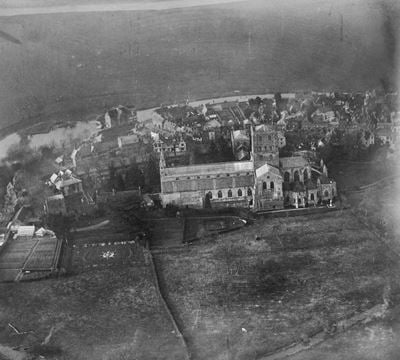
Tewkesbury
St Mary's Abbey Church, Tewkesbury, 1920

Tewkesbury
The town, Tewkesbury, 1953

Winchcombe
Sudeley Castle, Winchcombe, 1947

Winchcombe
Sudeley Castle, Winchcombe, 1953
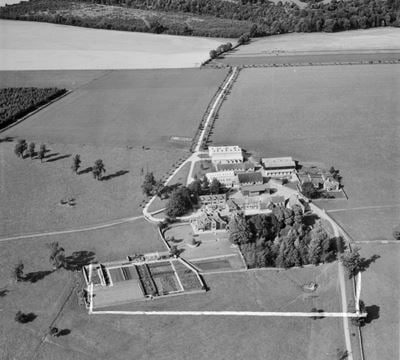
Snowshill
Snowshill Hill, Snowshill, 1952
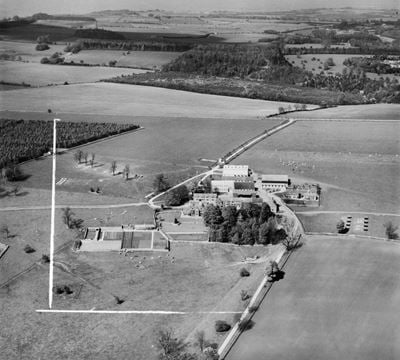
Snowshill
Snowshill Hill, Snowshill, 1953

Maisemore
Severnside House, Maisemore, 1947
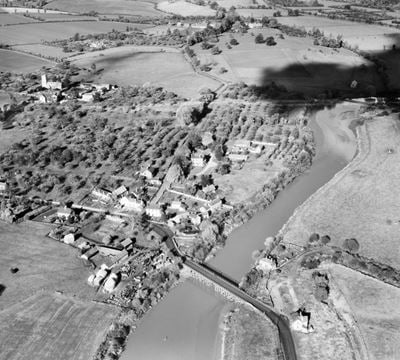
Maisemore
Maisemore Bridge and Severnside House alongside the River Severn (West Channel), Maisemore, 1947

Sandhurst
William Butler and Co Ltd Upper Parting Tar Works, Sandhurst, 1926

Sandhurst
William Butler and Co Ltd Upper Parting Tar Works, Sandhurst, 1926
Tewkesbury in the Historic England Archive
The Historic England Archive cares for over 15 million images, dating from the 1850s to the present day. Discover stunning images of Tewkesbury's past. Skip this section and go to stories about heritage
Charles George Harper Collection
Tewkesbury, Gloucestershire
Date created: 1892 - 1933
A view from the north looking towards the Black Bear Inn, with King John's Bridge in the foreground
Eric de Mare
Tewkesbury, Gloucestershire
Date created: 1945 - 1980
Interior view of Tewkesbury Abbey showing a sculpture of a pelican in a nest.
John Gay Collection: Counties
Tewkesbury, Gloucestershire
Date created: 1950s - 1960s
View through foliage to the North Transept and Tower of Tewkesbury Abbey. It was founded in 1087 by Robert Fitzhamon as a Benedictine Abbey church.
London, Midland and Scottish Railway Company
Ashchurch, Tewkesbury, Gloucestershire
Date created: 29 Nov 1927
The Cotswold Packing Company's fruit-canning factory and depot near Ashchurch Railway Station, as seen from the bridge to the south-west
Alfred Newton and Sons
Tewkesbury, Gloucestershire
Date created: 1896 - 1920
GENERAL VIEW OF MEN REAPING
Nigel Temple Collection of Postcards of Parks and Gardens
Tewkesbury, Gloucestershire
Date created: 1900 - 1930
EXTERIOR VIEW
Walter Scott
Tewkesbury, Gloucestershire
Date created: 1938
A view of the gargoyle above the window at the east end of the church
John Gay Collection: Counties
Tewkesbury, Gloucestershire
Date created: 1950s - 1960s
Elevated view of Tewkesbury's town centre, probably taken from the tower of Tewkesbury Abbey
London, Midland and Scottish Railway Company
Tewkesbury, Gloucestershire
Date created: 22 Apr 1892
An exterior view of the east end of Tewkesbury Abbey
Alfred Newton and Sons
Tewkesbury, Gloucestershire
Date created: 1896 - 1920
GENERAL VIEW SHOWING MAN WITH HORSE TEAM PLOUGHING IN FIELD
Nigel Temple Collection of Postcards of Parks and Gardens
Tewkesbury, Gloucestershire
Date created: 1902 - 1908
GENERAL VIEW SHOWING CANNON AND BANDSTAND
Walter Scott
Tewkesbury, Gloucestershire
Date created: 1938
The Tudor Hotel at 52 High Street viewd from the north east
Stories about heritage in your local area
Historic England publishes news, blogs, research, videos, and podcasts celebrating England's rich heritage. Discover the stories we have about Tewkesbury. Skip this section and go to education
How Did Shakespeare Hide the Truth Behind the Wars of the Roses Battlefields?
Mentions Battle of Tewkesbury 1471, Abbey Church of St Mary
Discover the myths and realities of England's historic battlefields in the Wars of the Roses as we celebrate the 30th anniversary of their register.
Uncovering Local History Hidden on our Streets
Mentions Fingerpost at junction of B4077 and Church Lane
From post boxes to milestones, drinking fountains to telephone boxes, historic street furniture can reveal lots about your local heritage.
The Rise and Fall of Anne Boleyn in 12 Historic Places
Mentions Sudeley Castle, Winchcombe Abbey
Discover the locations where Anne Boleyn lived, including Hever Castle, the Tower of London, and Hampton Court Palace.
Anglo-Saxon Architecture: Understated Jewels of England’s Heritage
Mentions The Church of St Mary, Odda's Chapel
Discover the legacy of Anglo-Saxon architecture including some of England’s oldest standing buildings.
Margaret of Anjou: Player in a Real Life Game of Thrones
Mentions Battle of Tewkesbury 1471
Margaret of Anjou, who Shakespeare later called ‘The She-Wolf of France’, was one of the major players in the late 15th century Wars of the Roses.
A Brief Introduction to Shopping Parades
Mentions Abbey Lawn Cottages
Shopping parades are a familiar sight in urban areas across England.
17 Remarkable Historic Places Listed in 2024
Mentions Fingerpost at junction of B4077 and Church Lane, Teddington Hands Sign Post, Tewkesbury
Celebrating 17 historic gems that were examined, protected and added to the National Heritage List for England in 2024.
Research Reports Roundup to February 2024
Mentions Tewkesbury
A roundup of new additions to the Historic England Research Reports database and a longer term overview of industrial heritage reports.
Research Reports Roundup August 2023
Mentions Tewkesbury
A roundup of recent research reports added to our database in June 2023 to August 2023, displayed by heritage themes.
Tewkesbury's social history through photos
Over 10,000 images from the Historic England Archive have been specially selected and re-captioned for teachers, students, and anyone who wants to learn more about their local area. Skip this section and go to grant-aided places
Tudor Hotel, Tewkesbury, Gloucestershire
Period: Tudor (1485 - 1602)
This is an unusually grand building. It was originally a large private house. It became a Court of Justice during James I's reign.
Tudor Hotel, Tewkesbury, Gloucestershire
Toddington Manor, Toddington, Gloucestershire
Period: Georgian (1714 - 1836)
This country house was built in 1820-30 by Charles Hanbury-Tracy. It is built in a Gothic Revivalist style of architecture.
Toddington Manor, Toddington, Gloucestershire
Tags
Tithe Barn, Stanway, Gloucestershire
Period: Medieval (Middle Ages) (1066 - 1484)
This tithe barn was built in about 1370 for the Abbot of Tewkesbury.
Tithe Barn, Stanway, Gloucestershire
Tags
The Palaces, Dumbleton, Gloucestershire
Period: Edwardian (1902 - 1913)
These four estate cottages were built in c1905. They are built in the Arts and Crafts style of architecture.
The Palaces, Dumbleton, Gloucestershire
The Old Police Station, Tewkesbury, Gloucestershire
Period: Georgian (1714 - 1836)
This building was originally Tewkesbury Gaol (jail). It was built in 1816, following an Act of 1813.
The Old Police Station, Tewkesbury, Gloucestershire
Tags
The Holm Hospital, Tewkesbury, Gloucestershire
Period: Georgian (1714 - 1836)
The building was built, because of an Act of Parliament, between 1792 and 1796 as a "House of Industry".
The Holm Hospital, Tewkesbury, Gloucestershire
The Bell Inn, Tewkesbury, Gloucestershire
Period: Victorian (1837 - 1901)
The exterior of the timber framed building, largely rebuilt in 1696.
School and Assembly Rooms, Winchcombe, Gloucestershire
Period: Victorian (1837 - 1901)
This building was built as a school in 1857. It was later used as a Working Men's Club and as Assembly Rooms.
School and Assembly Rooms, Winchcombe, Gloucestershire
Discover more
Ready for more local stories? Take a look at these other places nearby
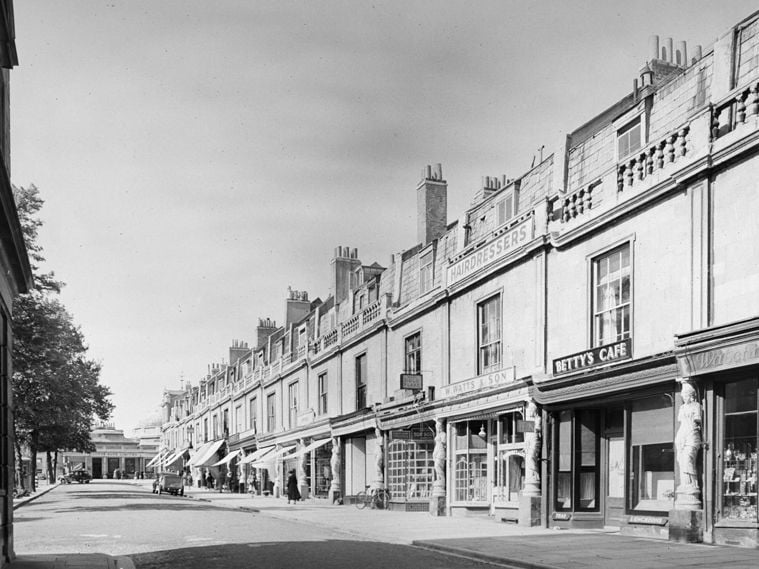
Cheltenham
Local Authority District
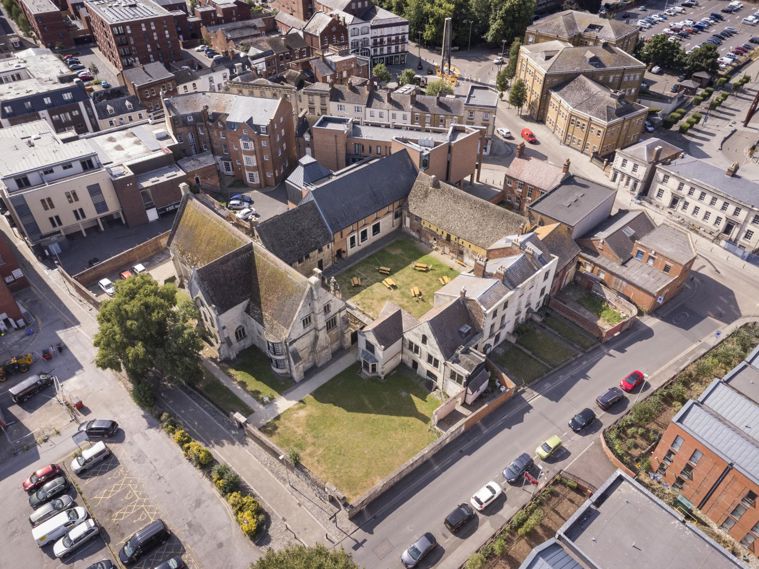
Gloucester
Local Authority District

Cotswold
Local Authority District